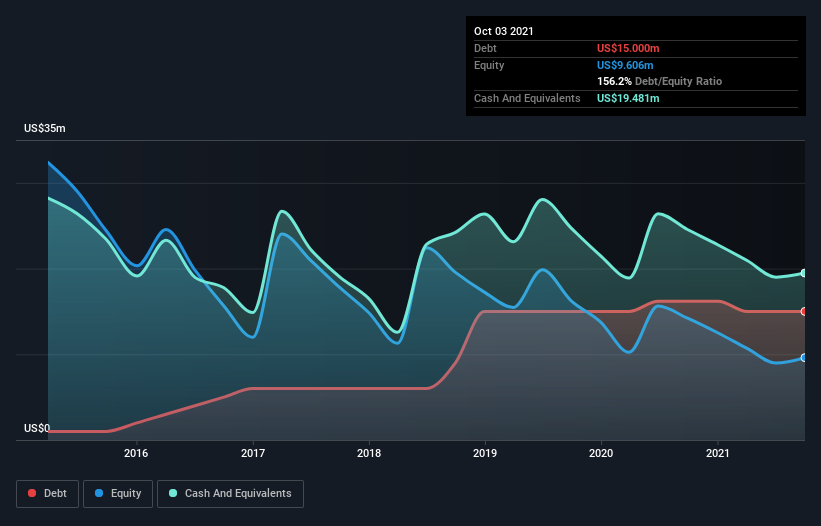
Warren Buffett famously said, 'Volatility is far from synonymous with risk.' It's only natural to consider a company's balance sheet when you examine how risky it is, since debt is often involved when a business collapses. Importantly, QuickLogic Corporation (NASDAQ:QUIK) does carry debt. But should shareholders be worried about its use of debt?
When Is Debt A Problem?
Debt and other liabilities become risky for a business when it cannot easily fulfill those obligations, either with free cash flow or by raising capital at an attractive price. Part and parcel of capitalism is the process of 'creative destruction' where failed businesses are mercilessly liquidated by their bankers. However, a more frequent (but still costly) occurrence is where a company must issue shares at bargain-basement prices, permanently diluting shareholders, just to shore up its balance sheet. Of course, plenty of companies use debt to fund growth, without any negative consequences. The first step when considering a company's debt levels is to consider its cash and debt together.
See our latest analysis for QuickLogic
What Is QuickLogic's Net Debt?
As you can see below, QuickLogic had US$15.0m of debt at October 2021, down from US$16.2m a year prior. But on the other hand it also has US$19.5m in cash, leading to a US$4.48m net cash position.

A Look At QuickLogic's Liabilities
The latest balance sheet data shows that QuickLogic had liabilities of US$18.9m due within a year, and liabilities of US$1.16m falling due after that. On the other hand, it had cash of US$19.5m and US$2.01m worth of receivables due within a year. So it can boast US$1.47m more liquid assets than total liabilities.
This short term liquidity is a sign that QuickLogic could probably pay off its debt with ease, as its balance sheet is far from stretched. Simply put, the fact that QuickLogic has more cash than debt is arguably a good indication that it can manage its debt safely. When analysing debt levels, the balance sheet is the obvious place to start. But it is future earnings, more than anything, that will determine QuickLogic's ability to maintain a healthy balance sheet going forward. So if you're focused on the future you can check out this free report showing analyst profit forecasts.
In the last year QuickLogic wasn't profitable at an EBIT level, but managed to grow its revenue by 28%, to US$11m. Shareholders probably have their fingers crossed that it can grow its way to profits.
So How Risky Is QuickLogic?
By their very nature companies that are losing money are more risky than those with a long history of profitability. And in the last year QuickLogic had an earnings before interest and tax (EBIT) loss, truth be told. And over the same period it saw negative free cash outflow of US$5.5m and booked a US$8.0m accounting loss. But at least it has US$4.48m on the balance sheet to spend on growth, near-term. With very solid revenue growth in the last year, QuickLogic may be on a path to profitability. By investing before those profits, shareholders take on more risk in the hope of bigger rewards. The balance sheet is clearly the area to focus on when you are analysing debt. However, not all investment risk resides within the balance sheet - far from it. For instance, we've identified 4 warning signs for QuickLogic that you should be aware of.
If, after all that, you're more interested in a fast growing company with a rock-solid balance sheet, then check out our list of net cash growth stocks without delay.
Valuation is complex, but we're here to simplify it.
Discover if QuickLogic might be undervalued or overvalued with our detailed analysis, featuring fair value estimates, potential risks, dividends, insider trades, and its financial condition.
Access Free AnalysisHave feedback on this article? Concerned about the content? Get in touch with us directly. Alternatively, email editorial-team (at) simplywallst.com.
This article by Simply Wall St is general in nature. We provide commentary based on historical data and analyst forecasts only using an unbiased methodology and our articles are not intended to be financial advice. It does not constitute a recommendation to buy or sell any stock, and does not take account of your objectives, or your financial situation. We aim to bring you long-term focused analysis driven by fundamental data. Note that our analysis may not factor in the latest price-sensitive company announcements or qualitative material. Simply Wall St has no position in any stocks mentioned.
About NasdaqCM:QUIK
QuickLogic
Operates as a fabless semiconductor company in the United States.
Excellent balance sheet slight.

